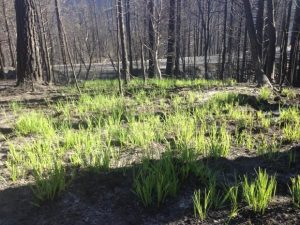July is designated as Smart Irrigation Month by the Irrigation Association. This month in California is when the rate of evapotranspiration – the use of water by plants and the loss of water from the soil – is highest. Consider reducing the area you have devoted to grass. It may be beautiful to look at, but less might just be more. There are several ways to accomplish this.
You might enlarge the space you have allowed around the base of trees, particularly all our drought-happy oaks. Cut away the sod and add it to your compost heap. Don’t plant these areas; just fill with your choice of mulch. This will focus the attention on the tree rather than on the bed beneath it.
How about enlarging the garden beds that are contiguous to the lawn? Lay out your garden hose to imagine another two feet or more of beds. If you’ve wanted to try some new low-growing perennials, this might be the time. Cut the new edge, lift the sod, turn over and chop, chop, chop. Let the old sod create compost, and by fall or next spring, it will be ready to plant. In the meantime you can be reading the catalogs and making your selections.
An excellent planning catalog that speaks to the conditions we have in the foothills is “High Country Gardens,” located in Santa Fe, New Mexico. Besides the enticing photographs, they offer good descriptions of plant growth habits and indicate which plants are deer and rabbit resistant, how much water they require, and whether the plant needs sun or shade. Call 800-925-9387. You can check out their website: http://www.highcountrygardens.com/ .
You could also create a new bed like an island within the lawn. Think green and low maintenance. Try planting a variety of shrubs with different colors and textures. Be sure all your selections require about the same amount of water and sun. You’ll be surprised what an interesting bed you will have created. The “look” will be quiet, serene, and even elegant— in contrast to your colorful beds elsewhere.
A more ambitious project would be to create a labyrinth within the lawn. Webster defines this word as a devious arrangement of linear patterns forming a design, and anything that is bewildering by its complexity. We envision a circular area, with paths that twist and turn leading eventually into the center and out again, the purpose being to allow slow meandering and meditating. Entering a labyrinth from the outside, you pad slowly along paths of tamped earth or decomposed granite, walking gently to and fro, in and out, until you reach the center…and then return. Think of it as a metaphor for life—we know not where our individual paths will lead.
All of these suggestions will require some alterations in the irrigation system, if there is one. You’ll be delighted with a new feature in your garden, which will reduce your dependence upon water. And you’ll love your shrinking water bill. Check with the Department of Water Resources Lawn Rebate Program: http://www.water.ca.gov/turf/
Joan Bergsund was a University of California Cooperative Extension Master Gardener of Tuolumne County.


